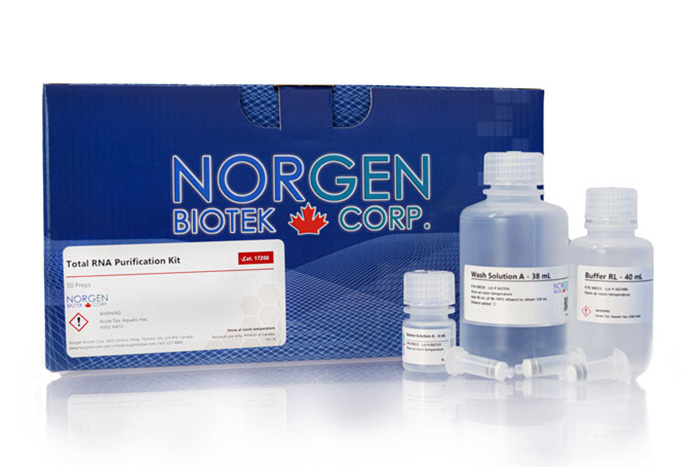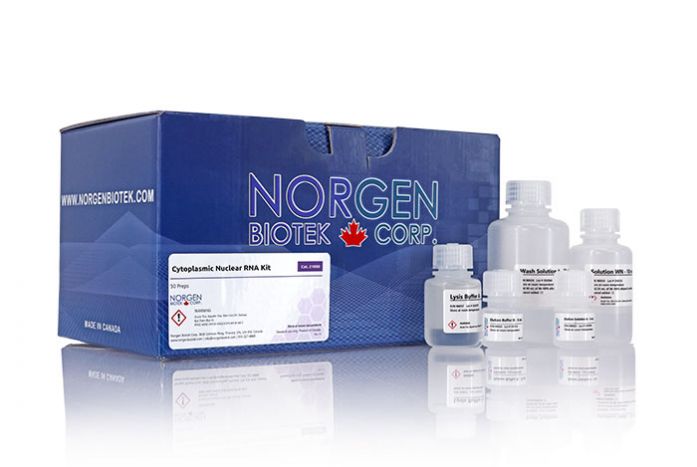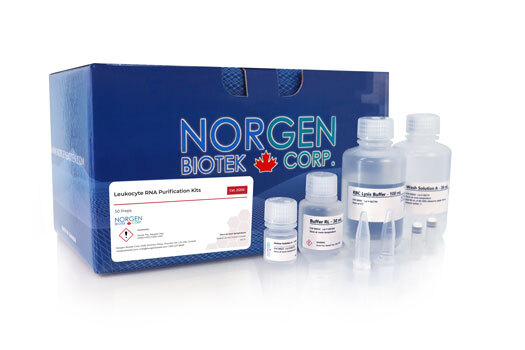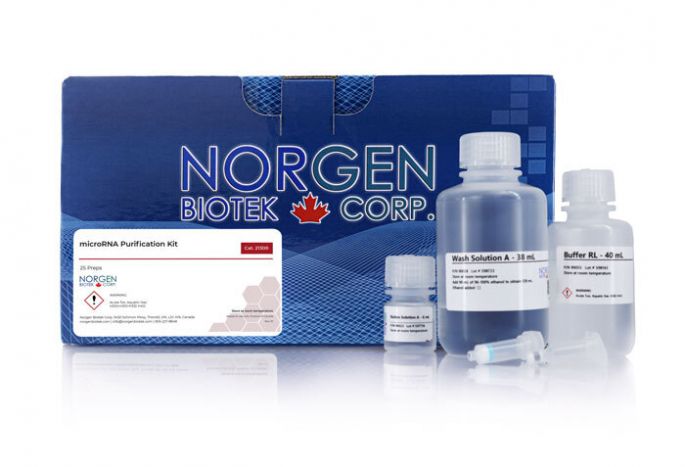CleanAll DNA/RNA Clean-Up and Concentration Micro Kit
For the rapid and efficient purification, cleanup and concentration of RNA or DNA




For research use only and NOT intended for in vitro diagnostics.
CleanAll DNA/RNA Clean-Up and Concentration Micro Kit
For the rapid and efficient purification, cleanup and concentration of RNA or DNA
Register today to receive an exclusive 15% off* on your first order.
Features and Benefits
- Can be used for the clean up of both RNA and DNA from enzymatic reactions, labeling etc.
- Purifies all sizes of RNA, from large mRNA down to microRNA (miRNA)
- Purifies all sizes of DNA, from small PCR products to plasmids to genomic DNA
- Removes endotoxins for transfection of injection ready RNA or DNA
- Rapid and efficient spin-column format (20 minutes)
- Purification is based on spin column chromatography that uses Norgen’s proprietary resin separation matrix
Norgen's CleanAll DNA/RNA Clean-Up and Concentration Micro Kit provides a rapid method for the purification, cleanup and concentration of RNA or DNA from different isolation methods or upstream applications. The kit can be used as an alternative to organic extraction and ethanol precipitation to clean up various enzymatic reactions.
The CleanAll Kit purifies RNA from phenol/guanidine-based protocols or from various upstream enzymatic reactions such as DNase treatment, labeling and in vitro transcription. Furthermore, endotoxins can be removed from previously purified RNA solutions.
The kit can be used to clean up DNA from digestions, ligations, PCR reactions, labeling reactions, DNA modification reactions and staining. The kit also provides a protocol for the rapid removal of endotoxins from previously purified DNA down to 0.1 EU/µg DNA or less.
Purify all sizes of RNA, from large mRNA and ribosomal RNA down to microRNA (miRNA) and small interfering RNA (siRNA).
Purify all sizes of DNA, from small PCR products, native or linearized plasmids, to genomic DNA. Using an alternative protocol, even oligonucleotides and smaller DNA fragments can be purified.
Details
Supporting Data
Figure 1. High Recoveries and Efficient Endotoxin Removal. High recoveries of DNA can be seen when using the CleanAll kit, and these high recoveries are not compromised even during endotoxin removal. In Panel A, 1 µg of a PCR product was cleaned using the CleanAll DNA/RNA Clean-Up and Concentration Micro Kit as well as Norgen's PCR Purification Kit. More than 0.9 µg of the DNA was recovered from both kits with a comparable percent recovery of over 90%. In Panel B, 10 µg of plasmid DNA preparation was cleaned from endotoxin by using the CleanAll DNA/RNA Kit. Endotoxin levels of the plasmid DNA sample were reduced from 0.75 EU/µg plasmid DNA to less 0.05 EU/µg plasmid DNA. Approximately 95% of the endotoxin units in the DNA sample were removed using the kit, therefore the kit allows for high recoveries coupled with exceptional cleanup.
Figure 2: Clean-Up of RNA with High Recovery. Norgen's CleanAll DNA/RNA Clean-Up and Concentration Micro Kit can be used to clean up various enzymatic reactions including DNase treatment. Lane 1 is the RNA input, while lanes 2-5 contain the RNA that has been cleaned using Norgen's CleanAll Kit. It can be seen that in all cases the recovery is high, and the purified RNA is intact and of a high quality.
|
Kit Specifications
|
|
| Column Binding Capacity |
50 μg RNA
10 μg DNA |
| Maximum Column Loading Volume |
600 μL
|
| Minimum Elution Volume |
20 μL
|
| Time to Complete 10 Purifications |
20 minutes
|
| Size of RNA Purified |
All sizes, including small RNA (<200)
|
| Size of DNA Purified |
≥ 100 bp*
|
| Average Recovery |
≥90% for RNA
≥90% for DNA 100 bp to 10 kbp ≥75% for DNA ≥ 10 kbp |
* Applicable to smaller fragments or oligonucleotides with alternative protocol
Storage Conditions and Product Stability
All solutions should be kept tightly sealed and stored at room temperature. This kit is stable for 2 years from the date of shipment.
Component | Cat. 23800 (50 preps) |
|---|---|
Binding Buffer H | 60 mL |
Wash Solution K | 27 mL |
Elution Buffer L | 15 mL |
Micro Spin Columns | 50 |
Collection Tubes | 50 |
Elution Tubes (1.7 mL) | 50 |
Product Insert | 1 |
Documentation
FAQs
Micro
Poor DNA recovery could be due to one or a combination of the following factors:
- Binding of DNA to the column was inefficient.
Binding of the DNA is dependent on both pH and salt concentration. Ensure that an appropriate amount of Binding Buffer H was used for the volume of the DNA input.
- The appropriate amount of ethanol was not added to the Wash Concentrate.
The Wash Solution K has been specifically designed to contain the appropriate amount of components. Ensure that the Wash Solution K was prepared using the correct amount of ethanol.
- Binding Buffer H was not completely removed in the wash step.
Traces of salt left on the column from the binding step may interfere with the elution of the DNA. Ensure that the column is washed with the Wash Solution K.
- Proper Elution Buffer was not used.
The provided Elution Buffer L has been optimized for high elution recoveries. If water or TE buffer is used instead, ensure the pH is around 8.
- Elution Buffer L was not placed directly onto the resin.
It is important that the Elution Buffer L be placed directly onto the resin, as this helps to increase recovery by ensuring an even passing of the buffer through the resin. Do not pipette the Elution Buffer L onto the side of the column.
- Insufficient washing of the column.
Ensure the column is washed thoroughly to remove any impurities that may affect DNA recovery. Proper washing with Wash Solution K is essential.
- Sample viscosity is too high.
High viscosity can impede the flow through the column. Dilute the sample if necessary to reduce viscosity and improve binding efficiency.
- Incorrect storage of reagents.
Ensure all reagents are stored according to the manufacturer's instructions. Improper storage can affect the performance of the buffers and overall DNA recovery.
This could be due to insufficient washing of resin with bound DNA. Traces of salt from the binding step may remain in the sample if the column is not properly washed with the Wash Solution K. Ensure that the column is spun for 2 minutes during the washing step. Salt may interfere with downstream applications, and thus must be washed from the column.
The CleanAll DNA/RNA Clean-Up and Concentration Micro Kit is designed to reduce endotoxin levels to below 0.1 EU/μg of DNA. However, higher endotoxin levels can be observed due to one or a combination of the following factors:
- Proper Elution Buffer was not used.
The provided Elution Buffer L has been optimized for endotoxin-free recoveries. If endotoxin-free water is used for the elution, ensure that the pH is between 7 and 8.
- A different Elution Buffer was used.
The provided Elution Buffer L has been optimized for endotoxin-free recoveries. The endotoxin-free properties of the eluted DNA will be compromised if another elution buffer is used. If a different elution buffer other than the one provided is used, the buffer should also be checked for endotoxin levels.
- The endotoxin levels of the input were extremely high.
If the initial input DNA had extremely high endotoxin levels, the levels may not be completely reduced to 0.1 EU/μg of DNA or less. In this case, the eluted DNA could be applied to a second column and the procedure repeated in order to further reduce the endotoxin levels.
Poor RNA recovery could be due to one or a combination of the following factors:
- Column has become clogged.
Do not exceed the recommended amounts of starting materials. The amount of starting material may need to be decreased if the column shows clogging below the recommended levels. See FAQ related to “Clogged Column” below.
- An alternative elution solution was used.
It is recommended that the Elution Buffer L supplied with this kit be used for maximum RNA recovery.
- Ethanol was not added to the lysate.
Ensure that the appropriate amount of ethanol is added to the lysate before binding to the column.
- Ethanol was not added to the Wash Solution K.
Ensure that 54 mL of 96-100% ethanol is added to the supplied Wash Solution K prior to use.
Column clogging can result from one or a combination of the following factors:
- High amounts of RNA as input.
Ensure that no more than 50 µg of RNA are used as input.
- High amounts of genomic DNA present in sample.
The lysate may be passed through a 25 gauge needle attached to a syringe 5-10 times in order to shear the genomic DNA prior to loading onto the column.
- Centrifuge temperature too low.
Ensure that the centrifuge remains at room temperature throughout the procedure. Temperatures below 15°C may cause precipitates to form that can cause the columns to clog.
Eluted RNA can be degraded due to the following factors:
- RNase contamination.
RNases may be introduced during the use of the kit. Ensure proper procedures are followed when working with RNA. Please refer to “Working with RNA” at the beginning of this user guide.
- Procedure not performed quickly enough.
In order to maintain the integrity of the RNA, it is important that the procedure be performed quickly.
- Improper storage of the purified RNA.
For short term storage RNA samples may be stored at –20℃ for a few days. It is recommended that samples be stored at –70℃ for longer term storage.
If purified RNA does not perform well in downstream applications, it can be due to the following reasons:
- RNA was not washed twice with the provided Wash Solution K.
Traces of salt from the binding step may remain in the sample if the column is not washed twice with Wash Solution K. Salt may interfere with downstream applications, and thus must be washed from the column.
- Ethanol carryover.
Ensure that the dry spin under the Column Wash procedure is performed, in order to remove traces of ethanol prior to elution. Ethanol is known to interfere with many downstream applications.
Using large amounts of starting material can cause DNA or genomic DNA contamination in the RNA fraction. Perform RNAse-free DNase I digestion on the RNA sample before clean-up according to the protocol provided in Appendix A.
Elution buffer L is an EDTA-free buffer.
Citations
| Title | From the Mountain to the Valley: Drivers of Groundwater Prokaryotic Communities along an Alpine River Corridor |
| Citation | Microorganisms 2023. |
| Authors | Alice Retter, Johannes Christoph Haas, Steffen Birk, Christine Stumpp, Bela Hausmann, Christian Griebler and Clemens Karwautz |
| Title | Microbial Community Succession Along a Chronosequence in Constructed Salt Marsh Soils |
| Citation | Microbial ecology 2023. |
| Authors | Carol Kim, Lorie W. Staver, Xuan Chen, Ashley Bulseco, Jeffrey C. Cornwell & Sairah Y. Malkin |
| Title | Microbial response to oil enrichment in Gulf of Mexico sediment measured using a novel long-term benthic lander system |
| Citation | Elementa Science of Athropocene 2017. |
| Authors | Orcutt, B. N., Lapham, L. L., Delaney, J., Sarode, N., Marshall, K. S., Whaley-Martin, K. J., ... & Girguis, P. R. (2017). |
| Title | Bioengineering novel chimeric microRNA-34a for prodrug cancer therapy: High-yield expression and purification, and structural and functional characterization |
| Citation | Journal of Pharmacology and Experimental Therapeutics 2015. |
| Authors | W Wang, PY Ho, Q Chen, B Addepalli, PA Limbach, M Li, W Wu, JL Jilek, J Qui, H Zhang, T Li, T Wun, RD White, KS Lam, A Yu |
| Title | Establishment of minigenome system for Oropuche orthobunyavirus reveals the S genome segment to be significantly longer than previously reported |
| Citation | Journal of General Virology 2014. |
| Authors | GO Acrani, NL Tilston-Lunel, M Spiegel, M Weidmann, M Dilcher, DE Andrade da Silva, MRT Nunes, RM Elliot |
| Title | Site- and horizon-specific patterns of microbial community structure and enzyme activities in permafront-affected soils of Greenland |
| Citation | Frontiers in Microbiology 2014. |
| Authors | A Gittel, J Barta, I Lacmanova, J Schnecker, B Wild, P Capek, C Kaiser, V Torsvic, A Richter, C Schleper, T Urich |
| Title | Distinct microbial communities associated with buried soils in the Siberian tundra |
| Citation | International Society for Microbial Ecology 2013. |
| Authors | A Gittel, J Barta, I Kohoutova, R Mikutta, S Owens, J Gilbert, J Schnecker, B Wild, B Hannisdal, J Maerez, N Lashchinskiy, P Capek, H Santruckova, N Gentsch, O Shibistova, G Guggenberger, A Richter, VL Torsvik, C Schleper, T Uruch |
| Title | Effect of DNA Contaminants on Calcium Phosphate-Based DNA Delivery and Gene Expression |
| Citation | Journal of Biotech Research 2012. |
| Authors | Mohamed and Dr. Haj-Ahmad |
| Title | Epigenetic Differences in Normal Colon Mucosa of Cancer Patients Suggest Altered Dietary Metabolic Pathways |
| Citation | Cancer Prevention Research 2012. |
| Authors | Matthew Silviera, Brian Smith, Jasmine Powell, et al. |
| Title | Genetic characterization of Erve virus, a European Nairovirus distantly related to Crimean-Congo hemorrhagic fever virus |
| Citation | Virus Genes 2012. |
| Authors | Meik Dilcher, Andrea Koch, Lekbira Hasib, Gerhard Dobter Frank Hufert |







